Under the sign of the North Star
 Bashny.Net
Bashny.Net
The place where a person without any special protective gear dies in a few minutes. This is not the surface of the moon or Mars' distant. It is loved by all the Arctic - an area extending over 66 ° 33 'with. w. (Polar Circle) and compares favorably with the rest of the Earth's average temperature negative. In this case, a "special protective means" means the maximum Insulated clothing and covered areas with mandatory source of heat.
Some photos taken for clarity ...
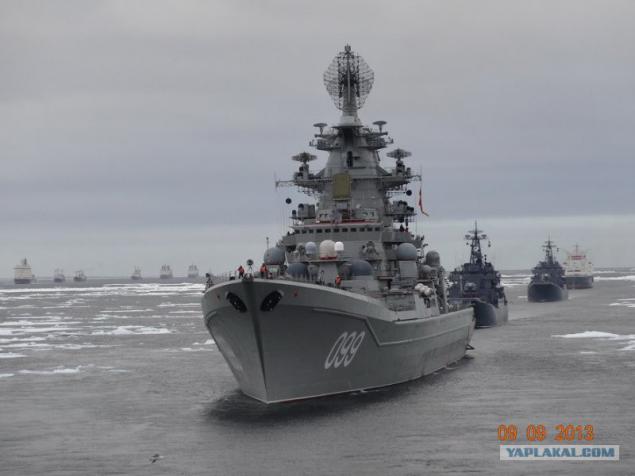
As you know, people in its original form is able to spend a few days behind the ship and safely transferred the air temperature above + 50 ° C. But in the Arctic, such tricks will not pass. This place is more dangerous than the Sahara and the Central Valley of Death, put together - one misstep in the frosty mist and cold zavernet brave the ram's horn. The next morning comrades find a stiff mummy ever with bent limbs.

"Land of the ice of terror" - that described the Arctic Norwegian Fridtjof Nansen after years of expeditions in these regions.
Fatal obstacle to the development of these places - the endless winter night (the length of the polar night is dependent on latitude).
When the edge of the solar disk will fly again in the south-eastern side of the sky, and the snowy landscape of hills illumined pale pink light in Murmansk celebrates the feast of the sun. Residents of Moscow and Kuban did not understand why so rejoice in the twilight of 300 thousand. Lucky - the inhabitants of the world's largest city built in the Arctic Circle.
The Arctic was not meant for human habitation. As if the very nature of this place is cursed forever pinning down a layer of earth and ocean durable as stone, ice. The monotonous snowy landscape and endless night - including polar walk mystical legend of "white noise" and "call of the North Star." Strange mental disorder among Pomors known as "meryachene" - a man loses his mind and runs off into the icy wilderness. According to legend, accidents always run straight north.
But no matter how severe the northern territories, they belong to us by right. To paraphrase Admiral Essen: "The other treatment we have. We have to use these. " And if so - Russian had to develop this area unsuitable for living and learn to reap the maximum benefit.
The main treasure of the Arctic today is the Northern Sea Route (NSR) - the strategic transport highway on the way from Europe to Asia; historical national unified transport communication in the Russian Arctic, stretching along the northern coast of the Urals, Siberia and the Far East.
The battle for the Arctic Ocean
The length of the maritime borders of the Russian state - 38,808 kilometers! Of which 19,724 km are along the coast of the Arctic Ocean: the Barents, Kara, Laptev, East Siberian and Chukchi seas. Year-round navigation without icebreaker is possible only in the Barents Sea, off the coast of the Kola Peninsula - where the warm Gulf Stream warms the water and the air, driving the ice far north. And then begins the "country of icy terror" - all ports of SMP, with the exception of Murmansk, running 2-4 months of the year - during the summer and autumn of navigation.
A mandatory attribute is the icebreaker fleet - contrary to popular assertion that "the longest sea borders", Russia de facto is the owner of the world's longest ice boundaries. Multimeter pack ice cover us from the north more reliable than any Coast Guard and Navy. With all the attendant advantages and disadvantages.
Unique Arctic trek warships of the Northern Fleet, which took place in September of the outgoing year, still is a mixed assessment: domestic and foreign analysts have expressed doubts about the advisability of the presence of nuclear-powered cruiser "Peter the Great" in high latitudes. On the question of whether to hold before such operations using surface warships, the former commander of the 5th Mediterranean operational squadron, Chief of Naval Staff Admiral Valentin Selivanov said bluntly:
No, we had it to anything - just wasting time and money. Ships go to sea, or on military training - the closer their ground, so it is more economical and easier, either on active service in the area of potential contact with the enemy. In the North Sea Route enemy never was. We had no reason to send ships.
TARKR "Peter the Great" was created as a hunter convoys and enemy naval group, but to imagine a US Navy carrier battle groups in the Kara Sea is absolutely impossible. Firstly, for it there are no problems. Second, the US surface fleet absolutely not suited for operations in the Arctic.
Last time the enemy appeared in these waters during the Great Patriotic War - in August 1942 in the Kara Sea broke through the heavy cruiser "Admiral Scheer". As a result, the raider was not able to catch up with the convoy on the way to the strait Velkitskogo - when Soviet ships and icebreakers were crawling at a speed of 5 knots. The Germans hardly issued 1-2 kt ... Heavy ice leveled all the advantages of "Scheer" in speed - the very nature of Arctic sea battle turned into a farce.

After wandering through the Kara Sea, the cruiser sank in an unequal battle icebreaker "Siberians" unsuccessfully fired Port Dickson - and get out. Risk superkorablem for such a worthless results Germans did not dare.
But that was then. Now things are different.
The uniqueness of the Arctic campaign in 2013 was the fact that the operation was attended by all Russian nuclear surface ships (cruiser and four Navy icebreaker Rosatomflota).
We can not remain indifferent to the mind wading through the ice icebreaker "Yamal", "Taimyr", "Vaigach" and "50 years of Victory" - the power, knows no boundaries! These magnificent machines will be where any other ship ever get stuck and will be crushed under the pressure of heavy ice. In 2013, the icebreaker "50 Years of Victory" celebrated a fantastic birthday - for the umpteenth time he got to the North Pole. These ships have unlimited autonomy for fuel supplies, long-term supply of food on board, are airplanes, the latest navigation and communication systems, and have the ability to destroy the ice thickness of more than 2, 5 meters. The true rulers of the Arctic - they are able to get to any area of the ice world.
"Taimyr" and "Vaigach". Entourage!

However, four of the icebreaker - it is an occasion to reflect. To post three warships and seven support vessels (TARKR "Peter the Great" landing ships "Kondopoga" and "Olenegorsky Miner", rescue tugs, the average sea transport and tanker) - for the wires of the caravan to the coast of the New Siberian Islands needed all icebreakers Russia ! Given that the campaign was carried out at the perfect time of the year - the beginning of September, the height of the navigation. When daytime temperatures higher than 0 ° C, and the southern edge of pack ice moves away far to the north.
No doubt, in the last decade, the sailors mark simplification ice situation - at the beginning of the XXI century there were precedents when during a single navigation NSR held court unaccompanied icebreakers. Pictures from space confirm the situation - the area of ice in the Arctic has declined.
But ... it had only to turn off the usual route - to take just to the north, in the direction of. Boilers (archipelago Siberian Islands) - and just needed help of four nuclear-powered icebreakers!
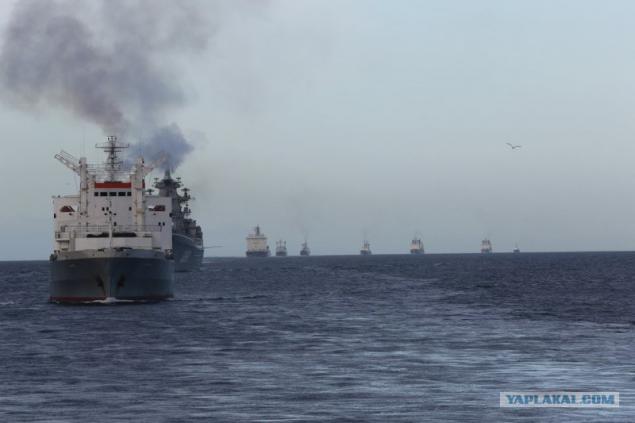
More
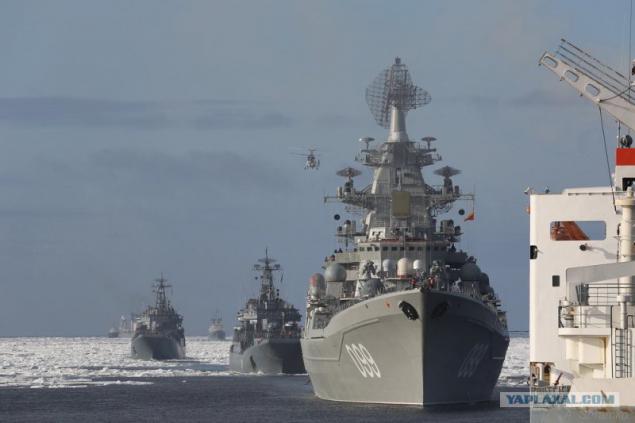
More

Naive Canadians are still hoping that the melting of Arctic ice will become irreversible - even a little bit, and open the Northwest Passage in the high latitudes, along the northern coast of Canada. The direct competitor of Russian SMEs!
Hell no. The myth of global warming is a hoax global scale - unscrupulous scientists and experts who exploit this hypothesis, are not inclined to tell the whole truth. The amount of ice in the Arctic is really decreased. But while the Antarctic ice cap, on the contrary, increased in thickness and size. Circulation of substances in nature!
It seems that we are dealing with some unexplored cyclic process between the northern and southern hemispheres - it is possible that in a few decades the Arctic ice will begin to re-tightened. Sweet dreams of the banana palms on the Franz Josef Land and arguments in the form of oil reserves in the Arctic shelf (which is 100% proof that millions of years ago on the ocean grew lush tropical forests) should not be led astray layman. It was hundreds of millions of years ago. And yet again a very long time.
We live in the coldest era in Earth's history - all the fault of Antarctica. If on-site ice-covered land in that place was the Southern Arctic Ocean, the climate on Earth would have been totally different. Antarctica vyholazhivaet Earth, is an excellent reflector of sunlight and drive the giant ice reserves. Alas, there are no trees in high latitudes, we see, as long as the damn "refrigerator" is not upolzet to another place, in obedience to the eternal movement of the lithospheric plates.
In the meantime ... the ships making their way through the chilled water along the coast of Russia. Icebreaker is a caravan - in spite of the broken, the discharged ice, the crew activates pnevmoobmyva (SOA - used to reduce friction on the ice building). This allows you to maximize channel at the stern of the icebreaker and facilitate the movement going in the wake of ships and vessels. Without knowledge of the subtleties in the northern seas do not survive.
Icing trunks towers GC cruiser "Belfast" during the posting of the Arctic convoy
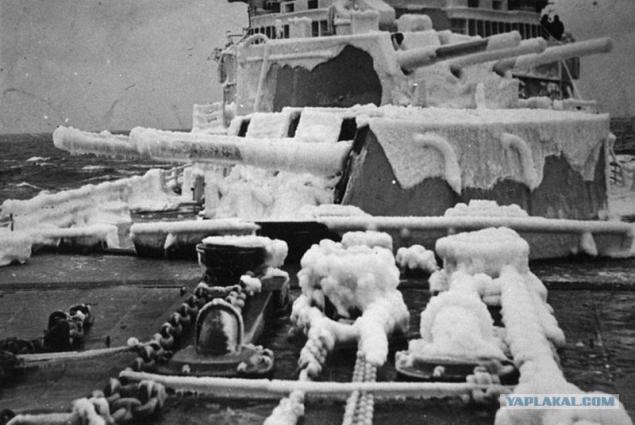
Shapeless figure ice - setting RBU-6000. Large anti-submarine ship "Admiral Isachenkov", Norwegian Sea, 1977
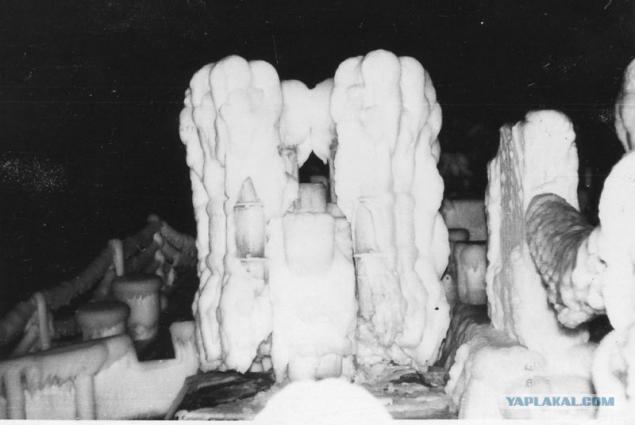
Ice-covered BOD "Admiral Yumashev»

Application of the Arctic squadron of surface warships considerable difficulties: the ships chained to maneuver. An additional gift for that trouble northern waters will be such an unpleasant process as icing. The scary thing is, during bad weather and storms it can in no bring the ship down, pinning down all the indestructible chains launchers, guns and radars. Polar night, the changeable weather, disgusting visibility - the rule rather than the exception for those latitudes. Obviously, even in the presence of aid in the form of nuclear-powered icebreakers, cruisers and destroyers (not to mention the "Mistral") doing absolutely nothing in the Arctic.
Yet there is only one class of warships that can challenge the primacy of nuclear icebreakers in the fight for the title of Master of the Arctic.
"Nautilus" was the first ship to reach the North Pole, August 3, 1958

Black streamlined submarine that rush to the North Pole without encountering any resistance. Nuclear submarines do not pay attention to the fields of impenetrable pack ice, are not afraid of the most severe frosts and polar blizzards. They do not suffer from icing and bad visibility. They are powerful, fast and are able to navigate the Arctic Ocean at any time of the year.
Ice, on the contrary, is for them a perfect cover and protection - no aircraft will be able to set or reset the sonobuoy torpedo. And no anti-submarine ship will not be able to keep up with the submarine in those latitudes - it is firmly stuck in the ice, without the ability to use their arms.
If required, the sonar will tell the crew the presence of open water or ice suitable thickness: submarine gently pressed against the inner surface of the ice, selling tanks and - voila! - Will lay chunks of broken ice, rise to the surface. In this sense, the most spectacular was a giant "Shark": due to its size, heavy SSBN ave. 941 could destroy its two-meter thick ice logging!
source
I have everything)
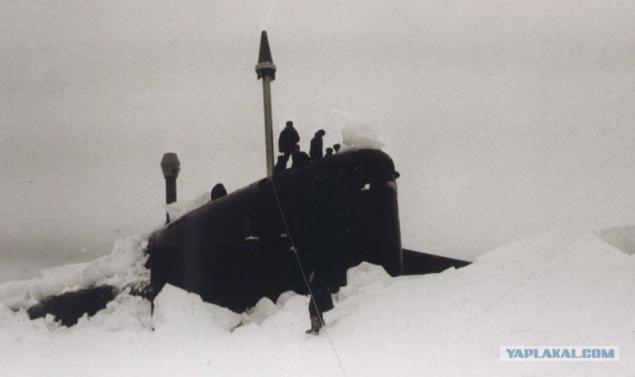
Source:
Some photos taken for clarity ...

As you know, people in its original form is able to spend a few days behind the ship and safely transferred the air temperature above + 50 ° C. But in the Arctic, such tricks will not pass. This place is more dangerous than the Sahara and the Central Valley of Death, put together - one misstep in the frosty mist and cold zavernet brave the ram's horn. The next morning comrades find a stiff mummy ever with bent limbs.

"Land of the ice of terror" - that described the Arctic Norwegian Fridtjof Nansen after years of expeditions in these regions.
Fatal obstacle to the development of these places - the endless winter night (the length of the polar night is dependent on latitude).
When the edge of the solar disk will fly again in the south-eastern side of the sky, and the snowy landscape of hills illumined pale pink light in Murmansk celebrates the feast of the sun. Residents of Moscow and Kuban did not understand why so rejoice in the twilight of 300 thousand. Lucky - the inhabitants of the world's largest city built in the Arctic Circle.
The Arctic was not meant for human habitation. As if the very nature of this place is cursed forever pinning down a layer of earth and ocean durable as stone, ice. The monotonous snowy landscape and endless night - including polar walk mystical legend of "white noise" and "call of the North Star." Strange mental disorder among Pomors known as "meryachene" - a man loses his mind and runs off into the icy wilderness. According to legend, accidents always run straight north.
But no matter how severe the northern territories, they belong to us by right. To paraphrase Admiral Essen: "The other treatment we have. We have to use these. " And if so - Russian had to develop this area unsuitable for living and learn to reap the maximum benefit.
The main treasure of the Arctic today is the Northern Sea Route (NSR) - the strategic transport highway on the way from Europe to Asia; historical national unified transport communication in the Russian Arctic, stretching along the northern coast of the Urals, Siberia and the Far East.
The battle for the Arctic Ocean
The length of the maritime borders of the Russian state - 38,808 kilometers! Of which 19,724 km are along the coast of the Arctic Ocean: the Barents, Kara, Laptev, East Siberian and Chukchi seas. Year-round navigation without icebreaker is possible only in the Barents Sea, off the coast of the Kola Peninsula - where the warm Gulf Stream warms the water and the air, driving the ice far north. And then begins the "country of icy terror" - all ports of SMP, with the exception of Murmansk, running 2-4 months of the year - during the summer and autumn of navigation.
A mandatory attribute is the icebreaker fleet - contrary to popular assertion that "the longest sea borders", Russia de facto is the owner of the world's longest ice boundaries. Multimeter pack ice cover us from the north more reliable than any Coast Guard and Navy. With all the attendant advantages and disadvantages.
Unique Arctic trek warships of the Northern Fleet, which took place in September of the outgoing year, still is a mixed assessment: domestic and foreign analysts have expressed doubts about the advisability of the presence of nuclear-powered cruiser "Peter the Great" in high latitudes. On the question of whether to hold before such operations using surface warships, the former commander of the 5th Mediterranean operational squadron, Chief of Naval Staff Admiral Valentin Selivanov said bluntly:
No, we had it to anything - just wasting time and money. Ships go to sea, or on military training - the closer their ground, so it is more economical and easier, either on active service in the area of potential contact with the enemy. In the North Sea Route enemy never was. We had no reason to send ships.
TARKR "Peter the Great" was created as a hunter convoys and enemy naval group, but to imagine a US Navy carrier battle groups in the Kara Sea is absolutely impossible. Firstly, for it there are no problems. Second, the US surface fleet absolutely not suited for operations in the Arctic.
Last time the enemy appeared in these waters during the Great Patriotic War - in August 1942 in the Kara Sea broke through the heavy cruiser "Admiral Scheer". As a result, the raider was not able to catch up with the convoy on the way to the strait Velkitskogo - when Soviet ships and icebreakers were crawling at a speed of 5 knots. The Germans hardly issued 1-2 kt ... Heavy ice leveled all the advantages of "Scheer" in speed - the very nature of Arctic sea battle turned into a farce.

After wandering through the Kara Sea, the cruiser sank in an unequal battle icebreaker "Siberians" unsuccessfully fired Port Dickson - and get out. Risk superkorablem for such a worthless results Germans did not dare.
But that was then. Now things are different.
The uniqueness of the Arctic campaign in 2013 was the fact that the operation was attended by all Russian nuclear surface ships (cruiser and four Navy icebreaker Rosatomflota).
We can not remain indifferent to the mind wading through the ice icebreaker "Yamal", "Taimyr", "Vaigach" and "50 years of Victory" - the power, knows no boundaries! These magnificent machines will be where any other ship ever get stuck and will be crushed under the pressure of heavy ice. In 2013, the icebreaker "50 Years of Victory" celebrated a fantastic birthday - for the umpteenth time he got to the North Pole. These ships have unlimited autonomy for fuel supplies, long-term supply of food on board, are airplanes, the latest navigation and communication systems, and have the ability to destroy the ice thickness of more than 2, 5 meters. The true rulers of the Arctic - they are able to get to any area of the ice world.
"Taimyr" and "Vaigach". Entourage!

However, four of the icebreaker - it is an occasion to reflect. To post three warships and seven support vessels (TARKR "Peter the Great" landing ships "Kondopoga" and "Olenegorsky Miner", rescue tugs, the average sea transport and tanker) - for the wires of the caravan to the coast of the New Siberian Islands needed all icebreakers Russia ! Given that the campaign was carried out at the perfect time of the year - the beginning of September, the height of the navigation. When daytime temperatures higher than 0 ° C, and the southern edge of pack ice moves away far to the north.
No doubt, in the last decade, the sailors mark simplification ice situation - at the beginning of the XXI century there were precedents when during a single navigation NSR held court unaccompanied icebreakers. Pictures from space confirm the situation - the area of ice in the Arctic has declined.
But ... it had only to turn off the usual route - to take just to the north, in the direction of. Boilers (archipelago Siberian Islands) - and just needed help of four nuclear-powered icebreakers!

More

More

Naive Canadians are still hoping that the melting of Arctic ice will become irreversible - even a little bit, and open the Northwest Passage in the high latitudes, along the northern coast of Canada. The direct competitor of Russian SMEs!
Hell no. The myth of global warming is a hoax global scale - unscrupulous scientists and experts who exploit this hypothesis, are not inclined to tell the whole truth. The amount of ice in the Arctic is really decreased. But while the Antarctic ice cap, on the contrary, increased in thickness and size. Circulation of substances in nature!
It seems that we are dealing with some unexplored cyclic process between the northern and southern hemispheres - it is possible that in a few decades the Arctic ice will begin to re-tightened. Sweet dreams of the banana palms on the Franz Josef Land and arguments in the form of oil reserves in the Arctic shelf (which is 100% proof that millions of years ago on the ocean grew lush tropical forests) should not be led astray layman. It was hundreds of millions of years ago. And yet again a very long time.
We live in the coldest era in Earth's history - all the fault of Antarctica. If on-site ice-covered land in that place was the Southern Arctic Ocean, the climate on Earth would have been totally different. Antarctica vyholazhivaet Earth, is an excellent reflector of sunlight and drive the giant ice reserves. Alas, there are no trees in high latitudes, we see, as long as the damn "refrigerator" is not upolzet to another place, in obedience to the eternal movement of the lithospheric plates.
In the meantime ... the ships making their way through the chilled water along the coast of Russia. Icebreaker is a caravan - in spite of the broken, the discharged ice, the crew activates pnevmoobmyva (SOA - used to reduce friction on the ice building). This allows you to maximize channel at the stern of the icebreaker and facilitate the movement going in the wake of ships and vessels. Without knowledge of the subtleties in the northern seas do not survive.
Icing trunks towers GC cruiser "Belfast" during the posting of the Arctic convoy

Shapeless figure ice - setting RBU-6000. Large anti-submarine ship "Admiral Isachenkov", Norwegian Sea, 1977

Ice-covered BOD "Admiral Yumashev»

Application of the Arctic squadron of surface warships considerable difficulties: the ships chained to maneuver. An additional gift for that trouble northern waters will be such an unpleasant process as icing. The scary thing is, during bad weather and storms it can in no bring the ship down, pinning down all the indestructible chains launchers, guns and radars. Polar night, the changeable weather, disgusting visibility - the rule rather than the exception for those latitudes. Obviously, even in the presence of aid in the form of nuclear-powered icebreakers, cruisers and destroyers (not to mention the "Mistral") doing absolutely nothing in the Arctic.
Yet there is only one class of warships that can challenge the primacy of nuclear icebreakers in the fight for the title of Master of the Arctic.
"Nautilus" was the first ship to reach the North Pole, August 3, 1958

Black streamlined submarine that rush to the North Pole without encountering any resistance. Nuclear submarines do not pay attention to the fields of impenetrable pack ice, are not afraid of the most severe frosts and polar blizzards. They do not suffer from icing and bad visibility. They are powerful, fast and are able to navigate the Arctic Ocean at any time of the year.
Ice, on the contrary, is for them a perfect cover and protection - no aircraft will be able to set or reset the sonobuoy torpedo. And no anti-submarine ship will not be able to keep up with the submarine in those latitudes - it is firmly stuck in the ice, without the ability to use their arms.
If required, the sonar will tell the crew the presence of open water or ice suitable thickness: submarine gently pressed against the inner surface of the ice, selling tanks and - voila! - Will lay chunks of broken ice, rise to the surface. In this sense, the most spectacular was a giant "Shark": due to its size, heavy SSBN ave. 941 could destroy its two-meter thick ice logging!
source
I have everything)

Source:
Tags
See also
Journey to the Arctic Circle
Technique 9 — learn is influenced by what stars you were born
"Amazing stuff" person.
ATTENTION! What to do if bitten by a tick
For 4 years this family lives in the Arctic circle. You'll be smitten when you see their house!
Arctic Circle - the kingdom of snow and ice. (27 photos)
A little creepy facts (1 picture + text)
Rosetta - the most interesting space mission in 2014
Rosetta - the most interesting space mission in 2014
What awaits human in space

















